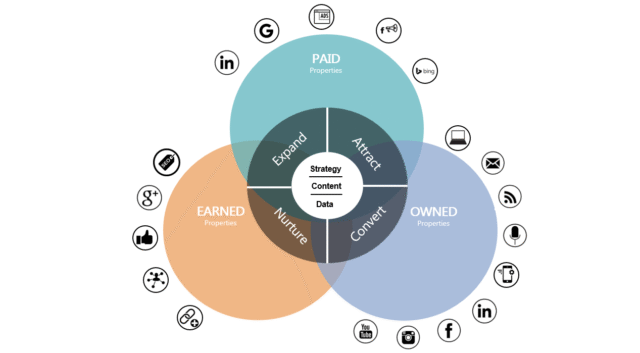Today’s marketing landscape demands more than isolated tactics. Successful companies recognize that inbound marketing works best as an interconnected ecosystem where each element strengthens the others. This approach transforms random marketing efforts into a coherent journey for potential customers.
The ecosystem concept matters because prospects rarely convert after a single interaction. Research consistently shows that consumers need multiple meaningful touchpoints before making purchase decisions. When these touchpoints connect logically, conversion rates climb dramatically.
Many businesses struggle because they implement inbound tactics in isolation. They might excel at blogging but neglect email nurturing, or invest heavily in social media without connecting it to their website strategy. This disconnected approach leaves potential revenue on the table.
The Foundation: Content That Connects
Content forms the foundation of any effective inbound ecosystem. But not just any content—it must serve as connective tissue between touchpoints.
Strong ecosystem content anticipates the reader’s next questions. Each piece should naturally guide prospects toward additional resources that deepen their understanding and move them forward in their journey.
At Inbound Marketo, we’ve seen conversion rates double when content strategically links to logical next steps rather than ending with no clear direction. This subtle difference transforms passive reading into active engagement.
Think of your content as a conversation rather than a broadcast. Each piece should pick up where the last left off, creating continuity that builds trust and momentum.
Mapping Touchpoints to the Buyer’s Journey
Different stages of the buyer’s journey require different types of touchpoints. Misalignment here often explains poor conversion rates despite quality content.
Awareness stage prospects need educational touchpoints that help them understand their problems better. Blog posts, infographics, and thought leadership content typically work best here.
Consideration stage prospects benefit from solution-focused touchpoints. Webinars, case studies, and comparison guides help them evaluate options effectively.
Decision stage prospects respond to validation touchpoints. Free trials, consultations, and specific product demonstrations address their need for confidence before purchasing.
The Digital Handshake: Transitioning Between Touchpoints
The moments between touchpoints often determine whether prospects continue their journey or abandon it. These transitions act as digital handshakes that maintain momentum.
Effective transitions always clarify the value of taking the next step. Rather than simply saying “download our guide,” explain precisely how that guide solves a problem the prospect is facing right now.
Personalization significantly strengthens these transitions. When your email nurturing acknowledges which blog post the prospect read or which webinar they attended, the connection feels natural rather than generic.
Visual consistency between touchpoints reduces cognitive friction. When design elements, voice, and messaging remain consistent, prospects focus on your value proposition rather than adjusting to changing contexts.
Structuring Your Email Nurturing Sequences
Email nurturing serves as the connective tissue in your inbound ecosystem, guiding prospects between major touchpoints with precision and care.
Strong nurturing sequences respond to behavioral signals rather than rigid timelines. When a prospect takes a specific action, your response should acknowledge and build upon that action.
Each email should serve a single clear purpose that advances the relationship. Trying to accomplish too much in one message often results in accomplishing nothing at all.
The best nurturing emails feel like thoughtful follow-ups from a knowledgeable consultant rather than automated marketing messages. They anticipate questions and provide answers before prospects even ask.
Creating Website Conversion Paths
Your website functions as the central hub of your inbound ecosystem, connecting various external touchpoints and facilitating conversion moments.
Effective websites offer multiple clearly defined paths based on visitor needs and awareness levels. One-size-fits-all approaches typically underperform compared to tailored journeys.
Strategic internal linking guides visitors toward conversion-focused pages naturally. Each page should contain contextual links to logical next steps based on the reader’s likely questions.
Page design should visually emphasize the most important next steps without overwhelming visitors with options. Clean, focused calls-to-action consistently outperform cluttered alternatives.
Social Media as an Ecosystem Extension
Social media platforms extend your inbound ecosystem, creating additional touchpoints that drive prospects toward your core conversion paths.
Each platform serves a specific role in your ecosystem. LinkedIn might focus on establishing authority, while Instagram showcases your culture and values through visual storytelling.
The strongest social strategies create platform-appropriate content that still maintains consistent messaging. The tone may shift slightly, but the underlying value proposition remains steady.
Social touchpoints should always provide clear pathways back to your owned conversion assets. Even the most engaging social content fails if it doesn’t connect to your broader ecosystem.
Measurement Across the Ecosystem
Traditional channel-specific metrics often miss the interconnected nature of effective inbound marketing. Ecosystem measurement requires broader thinking.
Multi-touch attribution helps identify which combinations of touchpoints drive the most valuable conversions. This approach reveals synergies that single-channel metrics miss entirely.
Time-to-conversion metrics across different entry points highlight which pathways move prospects most efficiently through your ecosystem. These insights help prioritize optimization efforts.
Customer journey analytics reveal where prospects commonly exit your ecosystem, identifying specific touchpoints that need improvement or better connections to subsequent steps.
Technology That Enables Ecosystem Marketing
The right technology stack makes ecosystem marketing manageable rather than overwhelming. Integration capabilities matter more than individual feature sets.
CRM systems serve as the central nervous system, tracking prospect interactions across multiple touchpoints and informing personalization efforts.
Marketing automation platforms execute the transitional elements of your ecosystem, ensuring timely follow-up based on prospect behaviors and characteristics.
Analytics tools provide the ecosystem-wide visibility necessary for continuous improvement, highlighting both strengths and weaknesses in your connected touchpoints.
Real-World Success Patterns
Companies that excel at ecosystem marketing typically start small, connecting just two or three touchpoints effectively before expanding. This focused approach builds capability and demonstrates value.
Cross-functional collaboration emerges as a consistent success factor. When content, web, email, and social teams align their efforts around the customer journey, ecosystem coherence naturally follows.
Regular customer journey audits help identify gaps or disconnects between touchpoints. The most successful organizations conduct these reviews quarterly, making incremental improvements with each cycle.
Building Your Ecosystem Strategy
Start by mapping your current touchpoints against your ideal customer journey. Where are the gaps? Where do connections feel forced or non-existent?
Focus initial improvements on transitions between your highest-traffic touchpoints. These connections typically offer the quickest conversion improvements.
Document your ecosystem visually so all team members understand how their work connects to the broader conversion strategy. This shared vision aligns efforts across channels.
Remember that building an effective inbound marketing ecosystem takes time and continuous refinement. The companies seeing the highest conversion rates today have been iteratively improving their connected touchpoints for years.
By thoughtfully building these connections between every element of your inbound strategy, you create an experience that naturally guides prospects toward conversion while providing genuine value at each step.




